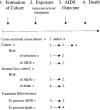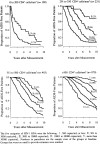The role of epidemiology in challenging the HIV/AIDS pandemic
- PMID: 11388499
- PMCID: PMC11638027
- DOI: 10.2188/jea.11.95
The role of epidemiology in challenging the HIV/AIDS pandemic
Abstract
The HIV/AIDS pandemic has challenged the resourcefulness of epidemiology and epidemiologists. In response to the challenge, epidemiologists have used existing epidemiologic strategies, expanded existing strategies, and developed new strategies to answer key questions about the transmission of HIV, the natural history of HIV at the molecular, host, and community levels, for evaluation of treatment effectiveness and intervention strategies, and to inform public health policy. In responding to the challenge of the pandemic, epidemiologists have also increasingly collaborated with scientists from other disciplines, particularly immunology, virology, and the behavioral sciences. Examples of the application of these epidemiologic strategies are presented.
Figures






Similar articles
-
Further escalation of the global HIV/AIDS epidemic in 2005 but one million patients on antiretroviral therapy.Euro Surveill. 2005 Nov 24;10(11):E051124.2. doi: 10.2807/esw.10.47.02838-en. Euro Surveill. 2005. PMID: 16794285
-
HIV-1 and HIV-Associated Nephropathy 25 Years Later.Clin J Am Soc Nephrol. 2007 Jul;2 Suppl 1:S20-4. doi: 10.2215/CJN.03561006. Clin J Am Soc Nephrol. 2007. PMID: 17699507 Review.
-
Overview of HIV.Psychosom Med. 2008 Jun;70(5):523-30. doi: 10.1097/PSY.0b013e31817ae69f. Psychosom Med. 2008. PMID: 18541903 Review.
-
Establishing valid AIDS monitoring and research in countries with generalized epidemics.Int J STD AIDS. 2004 Jan;15(1):1-6. doi: 10.1258/095646204322637173. Int J STD AIDS. 2004. PMID: 14769163 Review.
-
Advances in HIV/AIDS statistical methodology over the past decade.Stat Med. 1998 Jan 15;17(1):1-25. doi: 10.1002/(sici)1097-0258(19980115)17:1<1::aid-sim728>3.0.co;2-e. Stat Med. 1998. PMID: 9463846 Review.
Cited by
-
The past, present, and future of HIV prevention: integrating behavioral, biomedical, and structural intervention strategies for the next generation of HIV prevention.Annu Rev Clin Psychol. 2009;5:143-67. doi: 10.1146/annurev.clinpsy.032408.153530. Annu Rev Clin Psychol. 2009. PMID: 19327028 Free PMC article. Review.
References
-
- Joint United Nations Programme on HIV/AIDS (UNAIDS) and the World Health Organization (WHO) website: http://www.unaids.org/wac/2000/wad00/files/wad2000 Master/sld003. htm
-
- Detels R, Phair JP, Saah AJ, Rinaldo CR, Munoz A, Kaslow RA, Seminara D, Schrager L, Vermund S. Recent scientific contributions to understanding HIV/AIDS from the Multicenter AIDS Cohort Study. J Epidemiol [Jpn] 1992; 2(2): S11-S19.
-
- Detels R, English P, Visscher BR, Jacobson L, Kingsley LA, Chmiel JS, Dudley JP, Eldred LJ, Ginzburg HM. Seroconversion, sexual activity, and condom use among 2915 HIV seronegative men followed for up to 2 years. J Acquir Immune Defic Syndr 1989; 2: 77-83. - PubMed
-
- Munoz A, Sabin CA, Phillips AN. The incubation period of AIDS. AIDS 1997; 11 (Suppl A): S69-S76. - PubMed
-
- Detels R, Mann D, Carrington M, Hennessey K, Wu Z, Hirji KF, Wiley D, Visscher BR, Giorgi JV. Persistently seronegative men from whom HIV-1 has been isolated are genetically and immunologically distinct. Immunol Lett 1996; 51: 29-33. - PubMed
Publication types
MeSH terms
Grants and funding
- U01 AI035042/AI/NIAID NIH HHS/United States
- U01 AI037984/AI/NIAID NIH HHS/United States
- UO1-AI-35042/AI/NIAID NIH HHS/United States
- K01 TW000013/TW/FIC NIH HHS/United States
- UO1-AI35040/AI/NIAID NIH HHS/United States
- U01 AI035041/AI/NIAID NIH HHS/United States
- U01 AI035043/AI/NIAID NIH HHS/United States
- UO1-AI-35039/AI/NIAID NIH HHS/United States
- U01 AI035040/AI/NIAID NIH HHS/United States
- D43 TW000013/TW/FIC NIH HHS/United States
- U01 AI035039/AI/NIAID NIH HHS/United States
- UO1-AI-37984/AI/NIAID NIH HHS/United States
- 5-M01-RR-00052/RR/NCRR NIH HHS/United States
- U01 AI037613/AI/NIAID NIH HHS/United States
- UO1-AI-35041/AI/NIAID NIH HHS/United States
- TW00013/TW/FIC NIH HHS/United States
- M01 RR000052/RR/NCRR NIH HHS/United States
- UO1-AI-35043/AI/NIAID NIH HHS/United States
- UO1-AI-37613/AI/NIAID NIH HHS/United States

